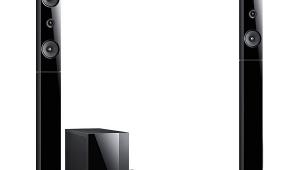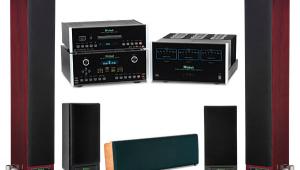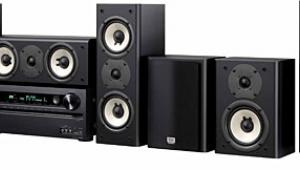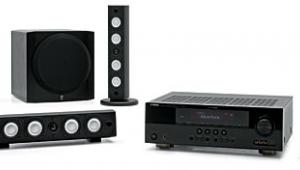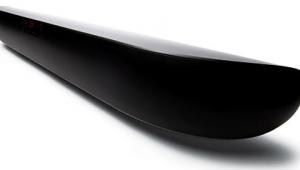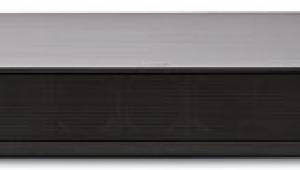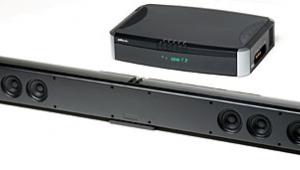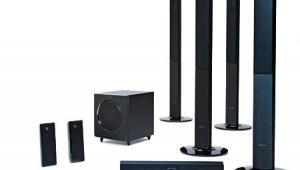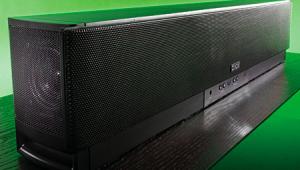Panasonic SC-BT100 Blu-ray HTIB
 Price: $1,000 Highlights: HTIB with Blu-ray drive • Wireless surround speakers • Bamboo fiber speaker cones
Price: $1,000 Highlights: HTIB with Blu-ray drive • Wireless surround speakers • Bamboo fiber speaker cones
Lady Sings the Blus
How do you define high end? Is it the gear that delivers the highest performance, sells for the highest price, or represents the most agile and innovative thinking? If that last criterion means anything, the Panasonic SC-BT100 is the very definition of a high-end home theater system—in a box. It includes a Blu-ray drive, makes daring use of bamboo fiber speaker diaphragms, and employs wireless technology to deliver signals to those two lonely surround speakers in the back of the room. Moving backward to the second criterion, price, the system sells for $1,000, on the moderate to high side by HTIB standards. And what about the first criterion, performance? Sorry, but you’ll have to read the review. Throw me a bone here—this is how I earn my living.
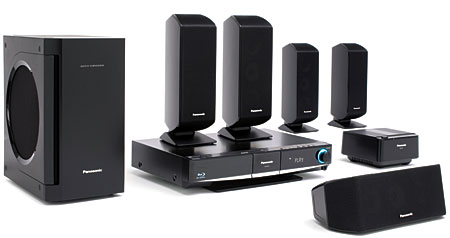
Kind of Blu, Kind of Bamboo
Thanks to digital amplifier technology, this system fits all of its amplification—and that oh-so-desirable Blu-ray Disc drive—into a box that’s one-third the height of a typical surround receiver. And that includes the sub amp. Digital amps are generally more energy efficient because they waste less power in the form of heat. They are well established in compact systems and have just started to take over the surround receiver category.
In one of many beautiful touches, Panasonic built a flip-down iPod dock into the center of the front panel. It operates through the onscreen interface via the system remote. There’s also an integrated SD card reader, so you can photograph unwary friends and family members, then remove the card from your camera, slip it into the HTIB, and provide your victims with instant replay on your mercilessly large screen.
Panasonic chose to make the drivers in the left, right, and center speakers out of bamboo fiber. The system has a not unpleasantly warm coloration. It can play loudly before it starts to break up and remains reasonably benign even when stressed at high volumes. When Panasonic introduced the SC-BT100 at a press conference, I was immediately impressed not only with how it sounded but with how it felt. When I turned it up moderately loud, it didn’t hurt. The front and center speakers are two-way models with 2.5-inch woofers and slightly smaller tweeters, while each of the surrounds uses a single full-range driver. All have plastic enclosures, and all but the center one rest on pedestals.
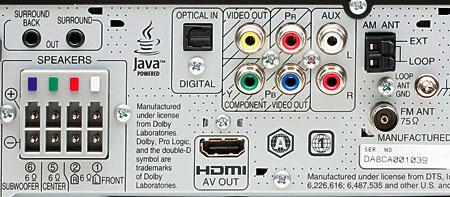
Panasonic notes explicitly that the subwoofer is a Kelton type (bandpass), with a passive radiator on the side and an active driver inside the box. It draws its power from the main system unit, not internally, by using a speaker cable hard-wired into the sub. There are no controls on the sub itself.
For prospective HTIB buyers who are leery of running cables to surround speakers, Panasonic provides moderate relief. The system includes an almost wireless surround feature. The system comes with a transmitter card that attaches to the SC-BT100 receiver unit’s back panel. This flings the signal to a receiver/amplifier at the back of the room, which feeds the speakers. The receiver/amplifier (which Panasonic calls a transceiver) re-quires an AC connection, operates at 2.4 gigahertz, and uses cables to reach the speakers.
 At about 9 feet, the cables may be on the short side for some rooms. They also have a proprietary connector at one end. If you need more cable, you’ll have to splice it onto the other end. Even though the system is designed for small rooms, this is one of its few design flaws—Panasonic should have provided longer cables. On the upside, the closer-than-usual surround-speaker placement gave me a chance to test the resilience of the speakers. I knocked one of the speakers to the floor three times to no ill effect. You can extend the system from 5.1 to 7.1 channels with the addition of another (optional) transceiver and pair of speakers.
At about 9 feet, the cables may be on the short side for some rooms. They also have a proprietary connector at one end. If you need more cable, you’ll have to splice it onto the other end. Even though the system is designed for small rooms, this is one of its few design flaws—Panasonic should have provided longer cables. On the upside, the closer-than-usual surround-speaker placement gave me a chance to test the resilience of the speakers. I knocked one of the speakers to the floor three times to no ill effect. You can extend the system from 5.1 to 7.1 channels with the addition of another (optional) transceiver and pair of speakers.
The main amp/disc/control unit is loaded with a Blu-ray player that’s capable of 1080p upconversion over HMDI. According to Panasonic, it is similar to the DMP-BD30 and includes that player’s UniPhier video processing technology. [See the April 2008 issue for a full review of that player.—Ed.] However, the HTIB player adds onboard decoding for Dolby TrueHD and DTS-HD Master Audio. The player is not BD-Live compatible, so this unit can’t play back the BD-Live interactive features we’ll see on some major Blu-ray releases later this year.
Setup is easy. Panasonic provides speaker cables for all channels, terminated with color-coded plugs. Each channel uses a different color. Panasonic designed the plug to fit only one way, so you can’t wire anything out of phase by accidentally inverting it. You could only invert it at the speaker end, where soldered wire tips fit into wire-clip terminals.
Bullies, Gangs, and Ad Men
The system booted up in about 15 seconds and displayed my first disc’s menu in less than 45 seconds. So, I counted down a minute before show time. That’s quite acceptable to me—and far better than early- generation Blu-ray players. All my movie selections were on Blu-ray Disc with high-resolution soundtracks.
 Drillbit Taylor (Dolby TrueHD) presents the Owen Wilson charm machine in a goofy comedy with bullied school kids. It took me half the movie to fine-tune the volume for dialogue clarity. I’m so used to adjusting systems with harsh-sounding tweeters that these relatively benign bamboo-infused drivers threw me off. My final volume preference was notably louder than my initial one.
I also spent time fiddling with the sub. I had to turn it down more than once. The system ships with the sub boost switched on and a very aggressive center volume setting. I used a front-panel button (not duplicated on the remote) to switch off the boost. Then I used the remote to knock the sub level down a couple more decibels. Oddly, the sub channel is the only one you can’t adjust in the onscreen menu. But along with the other channels, you can easily access it via a dedicated button on the remote in conjunction with the navigation keys and front-panel display.
Drillbit Taylor (Dolby TrueHD) presents the Owen Wilson charm machine in a goofy comedy with bullied school kids. It took me half the movie to fine-tune the volume for dialogue clarity. I’m so used to adjusting systems with harsh-sounding tweeters that these relatively benign bamboo-infused drivers threw me off. My final volume preference was notably louder than my initial one.
I also spent time fiddling with the sub. I had to turn it down more than once. The system ships with the sub boost switched on and a very aggressive center volume setting. I used a front-panel button (not duplicated on the remote) to switch off the boost. Then I used the remote to knock the sub level down a couple more decibels. Oddly, the sub channel is the only one you can’t adjust in the onscreen menu. But along with the other channels, you can easily access it via a dedicated button on the remote in conjunction with the navigation keys and front-panel display.
Gangs of New York (Dolby TrueHD) is full of wild dynamic swings, from Daniel Day Lewis’ definitively threatening sotto voce to the film’s riot scenes. With this system, even loud effects were rarely fatiguing. A cleverly mixed gunshot presented four separate events in the space of a second: the shot and its reverb, followed by the ricochet and its reverb. Shattering glass almost sounded musical. This film also includes a variety of tradi-tional music such as Irish, Chinese, and early-American fife-and-drum music. And the sweetening the Panasonic provided was just what the doctor ordered. War drums gallop through the movie’s action scenes and the sub delivered them powerfully.
Mad Men is the first TV-show-on-disc I’ve heard in DTS-HD Master Audio. Here, I made very few volume adjustments for dialogue, presumably because the show was produced for cable, and TV shows tend to have more idiot-proof vocal mixing. The varied music that accompanies the story of ad execs in the early 1960s came through well, especially the vocal-oriented jazz, which took on a creamy Madison Avenue suaveness. However, the sub revealed the limits of its pitch definition on string basses. A higher-end sub would have done this better. And it was still pretty loud, especially on the Lionsgate logo, so I knocked it down another decibel to –3 dB.
iPod Savvy
Normally the practice of dismembering classical works to generate mood-oriented releases nauseates me. But Decca’s two-disc set of Mozart Adagios (and a similar set called Vivaldi Adagios) is an exception. The source recordings and the sense of flow are both satisfying—making these excellent albums for low-level background listening on an iPod. When I plugged in my first-generation Nano, I heard the sweetening of the Panasonic sys-tem, with its bamboo drivers, slickly mitigate the MP3 artifacts at 192 kilobits per second. Even at foreground levels, the overall feel was nonfatiguing and listenable.
I like the beautifully designed full-color 16:9 onscreen display. It shows track, artist, and album name, along with an elapsed-time bar. There’s even a graphic that displays the remote’s navigation cluster—just in case you need to be reminded that the center button is Play, or that the Return button (comparable to the iPod’s Menu button) is on the lower right of the navigation wheel. The system also charged the iPod while the music played.
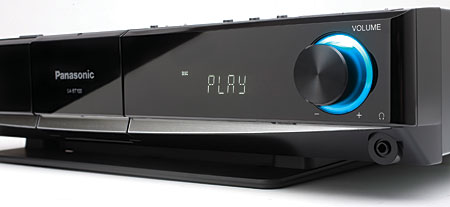
Not for Kids Only, the charming all-ages folkie CD by David Grisman and Jerry Garcia, bore the brunt of my experiments with stereo and the Dolby Pro Logic II Music mode. A lot of systems change their character completely when they switch between stereo source material in two channels and the same stuff processed into multiple channels via Dolby Pro Logic II (despite the fact that DPLII is tonally close to neutral). With this system, the soundfield opened up (of course), and the detail sharpened. But the album worked equally well in either mode; it imparted a golden warmth to the creaky vocals and the expertly wielded mandolin and acoustic guitar. I’m guessing this system will make a lot of folkies happy. Although the system uses different speaker designs in front and back, the timbre matching was quite good.
Once again, I turned to my Blu-ray copy of David Gilmour: Remember That Night–Live at the Royal Albert Hall and its Dolby TrueHD multichannel soundtrack. The Dark Side of the Moon side-one trilogy responded to the SC-BT100’s treatment with slightly rolled-off highs, a gorgeously communicative midrange that reveled in the lush Crosby/Nash vocal harmonies, and an open concert-hall feeling. I knew the system traded off some detail in the lossless soundtrack for soundfield size. Still, I liked the result.
The Panasonic SC-BT100 puts together a highly desirable feature package for $1,000, including Blu-ray playback, iPod compatibility, wireless surround-channel transmission, digital amplification, and speakers with bamboo drivers. I’ll go out on a limb and say that the new approach to HTIB speakers is the part that impresses me the most. And I’m far from unimpressed with the other stuff. This is one of the best in-a-box systems I’ve heard. It arguably makes the other disc-drive-inclusive models on my short list obsolete, since they only do standard-def DVD. So now I’ve got an HTIB short list of one. This system is it.
